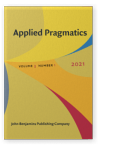Vol. 3:1 (2021) ► pp.1–25
Topic management and opportunities for learning in an advanced Francophone Cultures class
Drawing on conversation analysis and its extension to classroom discourse studies, this article examines the ways in which topic is managed and opportunities for learning are created in an advanced US university-level Francophone Cultures class. In the analysis, topic is treated as an ongoing interactional achievement rather than a stable “subject” of conversation. A single-case analysis is presented to show how topic is accomplished between the teacher and her students in relation to preference organization and epistemic stance. Specifically, the analysis demonstrates how a prototypical three-turn Initiation-Response-Feedback (IRF) sequence is elaborated over multiple turns that expand the teacher’s explicitly announced topic to include a side sequence addressing a metalinguistic problem and a disagreement between two students that results in an expansion of the topic beyond the teacher’s agenda. In the discussion, the results are synthesized in relation to how opportunities for learning emerge in the comanagement of topics. Implications for research and pedagogy are also offered.
Article outline
- 1.Introduction
- 2.Literature review
- 2.1Topic management and epistemics as interpersonal achievements
- 2.2Topic management in L2 classroom settings
- 2.3Contribution of the present study
- 3.Method
- 3.1Participants and data collection
- 3.2Identification of a recurring phenomenon
- 3.3Selection of a focal episode
- 4.Findings
- 4.1A prototypical three-turn sequence
- 4.2Shifting topics to repair misalignment
- 4.3Building on prior talk to expand beyond the topic-as-script
- 5.Discussion
- 5.1Summary of findings
- 5.2Implications for research, pedagogy, and assessment
- 5.3Limitations and future directions
- 6.Conclusion
-
References
